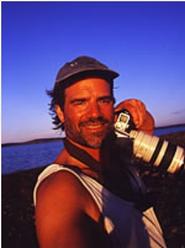
The Colorado River is one of the United States’ most impressive rivers. At 1,450 miles long, the river drains almost 250,000 square miles—10 percent of the United States—down the spine of the Continental Divide. The Colorado, though, is not as mighty as it once was. Because of population growth in the Southwest the Colorado no longer reaches the Pacific Ocean, but trickles dry in the deserts of northern Mexico. In his Nov. 1 talk in the Taylor Science Center, adventurer Jonathan Waterman detailed his journey down the Colorado and discussed the implications of the overuse of the river as a water resource.
Waterman already had several adventure books (and two BANFF Best Adventure Travel Book awards) under his belt when he decided to undertake his journey “from source to sea” down the Colorado. Waterman, originally from New England, was outraged in finding out that the Colorado, the most iconic western river, had been depleted of its majesty by overuse and lack of forward thinking.
Waterman began his solo journey in June of 2008 at the Colorado’s headwaters near Rocky Mountain National Park. His vessel was a small, 3-pound inflatable raft, and he tackled much of the tumultuous river by himself, though certain stretches of especially dangerous rapids required that he employ the help of a professional guide.
Over the course of his journey, he was able to meet and talk with many people—scientists, park and conservation agency officials, and locals with aesthetic and recreational interests—about the drying of the river. His somewhat sobering conclusion was that many people don’t care but many more people don’t even know what is happening to the once-mighty Colorado.
Waterman showed images of stretches of the river through the Grand Canyon in Arizona, where impressions and discolorations on the sandstone serve as reminders of the floodwaters that used to rage through the canyon as few as a hundred years ago. Modern marvels of engineering like the Hoover Dam, whose reservoir is the largest in the United States, have allowed desert cities in the southwest (Phoenix, Las Vegas, and Tuscon, for instance) to thrive, providing water resources where there are otherwise none.
Dams, though, have other effects, too. The Hoover Dam has been detrimental to many of the indigenous fish that live downstream because of the disruption and redirection of water flow. The water that comes out of the dam flows from the bottom of Lake Mead, and is much colder than traditional fish species are accustomed to. The added surface area of a lake compared to a river increases evaporation and puts an even greater strain on the water resources.
The river now peters out in the polluted muck of a delta south of the US-Mexico border. The delta was once the most spectacular desert estuary in the country, home to more than 300 species of birds, and Waterman thinks that the only chance of saving the river is to appeal to environmentalists’ sensibilities regarding the fragile estuary ecosystem that is in danger of drying up completely.
As cities in the southwest are predicted in the coming years to see populations expand to an even greater extent, Waterman emphasized that the time to act is now. The real solution, he said, is a change of mindset, where water conservation methods like drip irrigation are combined with lifestyle changes necessitated by the hot, dry climate—it just doesn’t make sense, he said, for suburban homes in Phoenix to have uncovered pools in the backyard. Waterman is hopeful that with the right amount of education and outreach, the Colorado can be at least preserved, if not restored to its former might.
